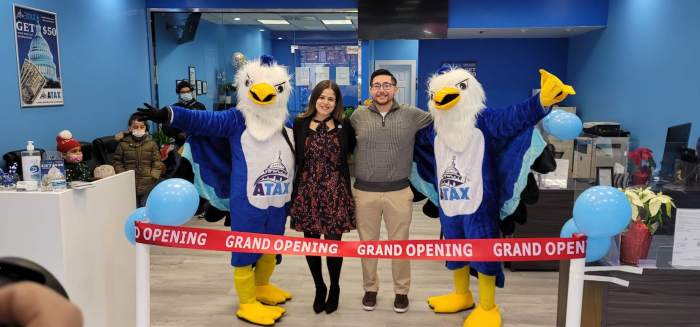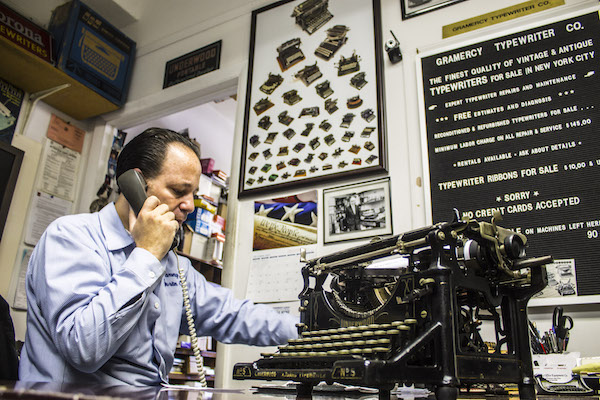
One piece of classic tech deserves another: Justin Schweitzer on a landline, at the thriving Gramercy Typewriter Company.
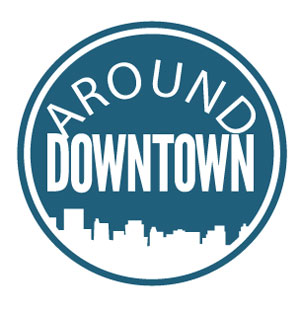 BY ZACH WILLIAMS | Business is booming at the 83-year-old Gramercy Typewriter Company, as a new generation discovers the staccato pace and simultaneous printing of a 19th-century innovation. This new clientele joins longtime customers who never gave up on the personal touch only a manual typewriter can provide.
BY ZACH WILLIAMS | Business is booming at the 83-year-old Gramercy Typewriter Company, as a new generation discovers the staccato pace and simultaneous printing of a 19th-century innovation. This new clientele joins longtime customers who never gave up on the personal touch only a manual typewriter can provide.
The father-son business is one of the last of its kind in Manhattan — just ask the “new guy” in the shop, located at 174 Fifth Ave. (btw. E. 22nd & E. 23rd Sts.). They are busier than ever with the tasks of fixing and selling manual typewriters, said Justin Schweitzer, 47, who began working with his father Paul, 76, more than 20 years ago.
“Due to this wave of new technology that we have nowadays, people just want to get away from the screen and go back to basics,” Justin said. “Certainly it is a way to get away from all of the distractions that you find sitting in front of the computer.”
Justin started in the business as a kid, just like his father. There were the early childhood memories watching dad tinker with the machines, and then a gradual apprenticeship at his side. In this line of work, winding ribbons and buffing the body of a fine typing machine are the entry-level tasks until the correct habits become second nature.
Summer vacations during elementary school were for work rather than lounging around the house watching cartoons, his father told Justin as a kid. Forgetting the whereabouts of little bolts and springs or inadvertently damaging the carriage, instilled a sense of organization necessary to hack it as a reliable professional beginning in his early 20s, he said.
Though such rookie mistakes occurred long ago, seniority remains elusive through a paradox inherent to any son who learns from his father, Justin said with a chuckle.
“Oh my goodness, listen, you know with my dad around, no matter how long I stay or how many years I put in, I’m always going to be the new guy,” he said.
His childhood coincided with the rise of the personal computer and printers that began supplanting the once-ubiquitous typewriter in the 1980s and 1990s. In the old days, large companies would have more than 500 typewriters in their offices. Nowadays they might still have 20 or 30 left for specific tasks such as filling out forms that are not easily recognized by computer programs, Paul said.
He saw the writing on the wall about 25 years ago and expanded the business to include the repair of Hewlett-Packard printers. By the turn of the century, companies churned out the last of the electric typewriters, and it seemed that manual typewriters would be relegated to a mere curiosity of the past, something for the eccentric antique enthusiast or people of older generations unwilling to change.
But in the last few years typewriter repairs and sales have bounced back to about a quarter of the overall business that relies on the printer repair side. A certain pushback is underway against the dominance of the computer screen, as teenagers and twentysomethings begin to appreciate that the old way of putting words onto paper has an irreplaceable value, said Paul.
“You are able to get a lot of work done. It’s very enjoyable to see the results once you’ve sat at the machine for a while typing away and all the work you can accomplish,” said Justin. “You feel more in control of what you’re doing. Plus you’re able to use a machine that, because of the craftsmanship and how they were made, will continue to work for decades to come.”
Each week, dozens of customers bring old Remingtons, Olympias, Underwoods, and IBMs up to the fourth-floor business. Others pay $150 to more than $500 to buy restored models from the first half of the 20th century. A pink Royal grabs the eye, but connoisseurs of older vintages also have options among the many models for sale.
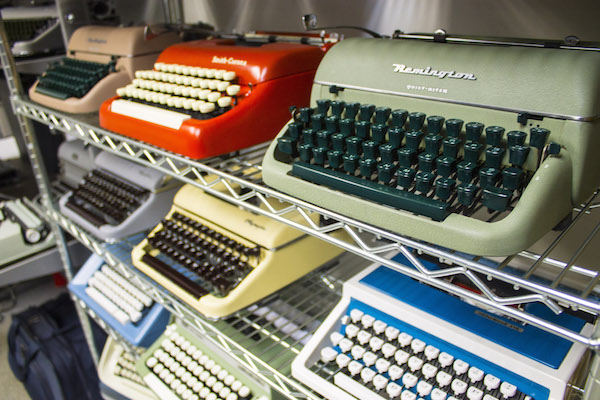
Unlike almost any other business in New York City, there is no computer and not a smartphone to be seen within the small office, which has a cramped workshop in back. Invoices and receipts are typed, and the old-fashioned approach extends to the dress code: a collared shirt and tie.
A generational gap, though, sometimes means that customers know what they want even if they cannot describe it in proper terms, said Justin. Luckily for them, the “new guy” in the typewriter business has a keen sense for when to lend an increasingly rare expertise.
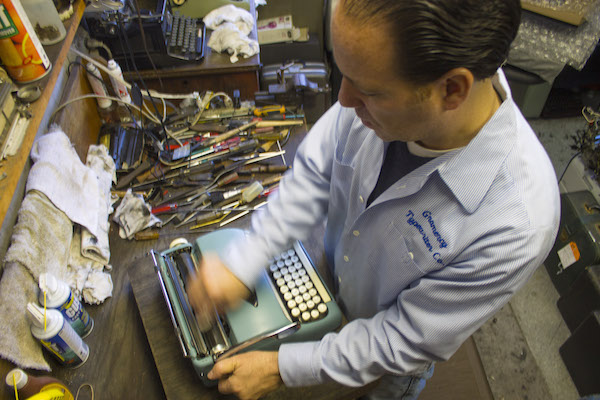
Downtown Express photos by Zach Williams
“Customers have called up asking if we sell ‘those old things, those old computers.’ I say, ‘No, we don’t sell those.’ They say, ‘sure you do, I saw the photos,’” he said. “I says, ‘Wait a minute, I says, do you mean typewriter?’ They say, ‘Yeah, yeah, yeah, that’s what I mean, typewriter.’ I says, ‘Oh yeah, those we have.’”














